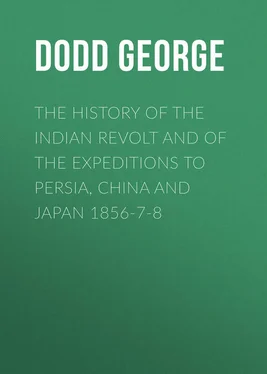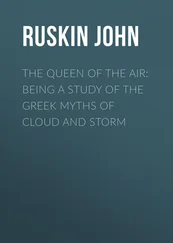George Dodd - The History of the Indian Revolt and of the Expeditions to Persia, China and Japan 1856-7-8
Здесь есть возможность читать онлайн «George Dodd - The History of the Indian Revolt and of the Expeditions to Persia, China and Japan 1856-7-8» — ознакомительный отрывок электронной книги совершенно бесплатно, а после прочтения отрывка купить полную версию. В некоторых случаях можно слушать аудио, скачать через торрент в формате fb2 и присутствует краткое содержание. Жанр: foreign_antique, foreign_prose, на английском языке. Описание произведения, (предисловие) а так же отзывы посетителей доступны на портале библиотеки ЛибКат.
- Название:The History of the Indian Revolt and of the Expeditions to Persia, China and Japan 1856-7-8
- Автор:
- Жанр:
- Год:неизвестен
- ISBN:нет данных
- Рейтинг книги:3 / 5. Голосов: 1
-
Избранное:Добавить в избранное
- Отзывы:
-
Ваша оценка:
- 60
- 1
- 2
- 3
- 4
- 5
The History of the Indian Revolt and of the Expeditions to Persia, China and Japan 1856-7-8: краткое содержание, описание и аннотация
Предлагаем к чтению аннотацию, описание, краткое содержание или предисловие (зависит от того, что написал сам автор книги «The History of the Indian Revolt and of the Expeditions to Persia, China and Japan 1856-7-8»). Если вы не нашли необходимую информацию о книге — напишите в комментариях, мы постараемся отыскать её.
The History of the Indian Revolt and of the Expeditions to Persia, China and Japan 1856-7-8 — читать онлайн ознакомительный отрывок
Ниже представлен текст книги, разбитый по страницам. Система сохранения места последней прочитанной страницы, позволяет с удобством читать онлайн бесплатно книгу «The History of the Indian Revolt and of the Expeditions to Persia, China and Japan 1856-7-8», без необходимости каждый раз заново искать на чём Вы остановились. Поставьте закладку, и сможете в любой момент перейти на страницу, на которой закончили чтение.
Интервал:
Закладка:
Next, we may usefully pay a little attention to this question – How, in so immense a country, do the soldiers and subjects of these several states, British and native, travel from place to place: how do they cross mountains where passes are few, or marshes and sandy plains where roads are few and bad, or broad rivers where bridges are scarce? The distances traversed by the armies are sometimes enormous. Let us open a map of India, and see, for example, the relative positions of Calcutta, Madras, Bombay, Delhi, Peshawur, and Kurachee at the western mouth of the Indus. Delhi is nearly nine hundred miles from Bombay, more than nine hundred from Calcutta by land, fifteen or sixteen hundred miles from the same city by water-route up the Ganges and Jumna, and nearly fourteen hundred from Madras. Kurachee, the most westerly spot in India, and destined one day, perhaps, to be an important depôt for steamers from the Red Sea or the Persian Gulf, is more than sixteen hundred miles from Calcutta, nearly across the broadest part of India from east to west; while Peshawur, at the extreme northwest or Afghan frontier, acquired by England when the Punjaub was annexed, is no less than two thousand miles from Madras. All opinions and judgments, concerning the slowness of operations in India, must be tempered by a consideration of these vast distances.
The rivers were the great highways of that country before roads existed, as in other regions; and they have never ceased to be the most frequented routes. At least such is the case in relation to the larger rivers – such as the Ganges, Indus, Nerbudda, Kishna, Jumna, Sutlej, and Jelum. Hindoos and Mohammedans, too poor to hire horses or palkees for land-travel, may yet be able to avail themselves of their river-boats.
The native boats which work on the Ganges are numerous and curious in kind. The patella or baggage-boat is of saul-wood, clinker-built, and flat-bottomed, with rather slanting outsides, and not so manageable as a punt or a London barge; its great breadth gives it a very light draught of water, and renders it fittest for the cotton and other up-country products, which require little more than a dry and secure raft to float them down the stream. The oolak or common baggage-boat of the Hoogly and Central Bengal, has a sharp bow and smooth rounded sides; it is fitted for tracking and sailing before the wind, and is tolerably manageable with the oar in smooth water. The Dacca pulwar is more weatherly, although, like the rest, without keel, and the fastest and most handy boat in use for general traffic. The budgerow , the bauleah , and the ketch-rigged pinnace, are employed by Europeans for their personal conveyance. Besides these, there are numerous others – such as the wood-boats of the Sunderbunds, of various forms and dimensions – from one hundred to six thousand maunds burden (a maund being about equal to 100 pounds troy); the salt-boats of Tumlook; the light boats which carry betel-leaf; the Calcutta bhur , or cargo-boat of the port; the Chittagong boats; the light mug -boats, with floors of a single hollowed piece of timber, and raised sides, neatly attached by sewing, with strips of bamboo over the seams; the dinghee ; and the panswee – all found within the limits of the Bengal presidency. ‘A native traveller, according to his degree and substance, engages a dinghee or a panswee, a pulwar or an oolak; the man of wealth puts his baggage and attendants in these, and provides a budgerow or a pinnace for his personal accommodation. Officers of high standing in the civil or military service, travelling with a large retinue of servants and a quantity of baggage, seldom have less than five or six boats (one of them a cooking-boat, and another fitted with an oven for baking bread): sometimes as many as fifteen when they carry their horses and equipages, and the materials of housekeeping for their comfortable establishment on arrival.’
Before Indian steamers were introduced, or Indian railways thought of, the Ganges was the great highway from Calcutta to Benares, Allahabad, and the northwestern provinces generally, in all cases where speed was not required. The Indian government used to allow their military servants two months and a half for proceeding to Benares, three to Allahabad, five to Meerut, and nine to Loodianah – periods that seem to us, in the old country, outrageous in their length. The boats were chiefly of two of the kinds mentioned in the preceding paragraph – namely, the pinnace, very European in its appearance, and the lofty sterned budgerow, peculiarly Indian. Even after steamers were placed upon the Ganges, the slow-going budgerow continued to be much used by the Company’s officers, and by other persons going northwest – chiefly in cases where a family and a large quantity of luggage or personal effects had to be conveyed; for every other mode than the budgerow then becomes very costly – and will probably so continue until the great trunk-railway is completed. Budgerow boating is, it must be confessed, enough to stagnate the blood of an active man who wishes to speed onward to a scene of usefulness. As the tide ends at a few miles above Calcutta, there is a constant downward current throughout all the rest of the Ganges; and this current has to be struggled against during the up-passage. If the wind be favourable, sails are hoisted; but if otherwise, progress is made by gooning or tracking, an operation performed by the greater part of the crew proceeding on shore, and with ropes attached to the mast-head, dragging the vessel bodily along: wading for hours, it may be, through nullahs or creeks more than breast high. The travellers spend much of their time on shore in the cooler hours of the morning and evening, walking, fishing, or shooting, or otherwise whiling away their time; for they can easily keep up with a boat that only makes ten miles per average day. The Company have been accustomed to make a certain allowance to each officer for boat-accommodation up the country; and it is not unusual for two or three to join in the hire of one budgerow, to their mutual comfort, and with a small saving out of their allowance. They engage an attendant dinghee as a cook-boat, to keep the culinary operations at a respectful distance; and they fit up their budgerow with camp-tables, camp-stools, charpoys or light bedsteads, copper chillumchees or wash-basins, rugs, hanging lamps, canteens, bullock or camel trunks, and a few other articles of furniture; with wine, spirits, ale, preserves, cheeses, pickles, salt meats, hams, tongues, and other provisions, which are cheaper at Calcutta than if purchased on the way; and with their wardrobes, articles for the toilet, books, chess and backgammon boards, guns, musical instruments, and other aids to lessen the tedium of a long voyage.
Hitherto, commerce has had so much more to do with this Ganges traffic than passenger travel, that the slowness of the progress was not felt: as in the instance of the canals of England, which, made for goods and not for passengers, are not blameable on the score of tardiness. The Ganges is now, as it has been for ages, the main channel for the commerce of Northern India. The produce of Europe, of Southern India, of the Eastern Archipelago, of China, brought to Calcutta by ocean-going steamers or sailing-ships, is distributed upwards to Patna, Benares, Allahabad, Lucknow, Cawnpore, Agra, Delhi, and other great towns, almost exclusively by the Ganges route; and the same boats which convey these cargoes, bring down the raw cotton, indigo, opium, rice, sugar, grain, rich stuffs, piece-goods, and other grown or manufactured commodities from the interior, either for consumption at Calcutta and other towns on the route, or for shipment to England and elsewhere. It is probable that the cargo-boats and the budgerows will continue to convey a largo proportion of the traffic of India, let steamers and railways make what progress they may; for there is much local trading that can be better managed by this slow, stopping, free-and-easy Ganges route of boating.
Читать дальшеИнтервал:
Закладка:
Похожие книги на «The History of the Indian Revolt and of the Expeditions to Persia, China and Japan 1856-7-8»
Представляем Вашему вниманию похожие книги на «The History of the Indian Revolt and of the Expeditions to Persia, China and Japan 1856-7-8» списком для выбора. Мы отобрали схожую по названию и смыслу литературу в надежде предоставить читателям больше вариантов отыскать новые, интересные, ещё непрочитанные произведения.
Обсуждение, отзывы о книге «The History of the Indian Revolt and of the Expeditions to Persia, China and Japan 1856-7-8» и просто собственные мнения читателей. Оставьте ваши комментарии, напишите, что Вы думаете о произведении, его смысле или главных героях. Укажите что конкретно понравилось, а что нет, и почему Вы так считаете.












